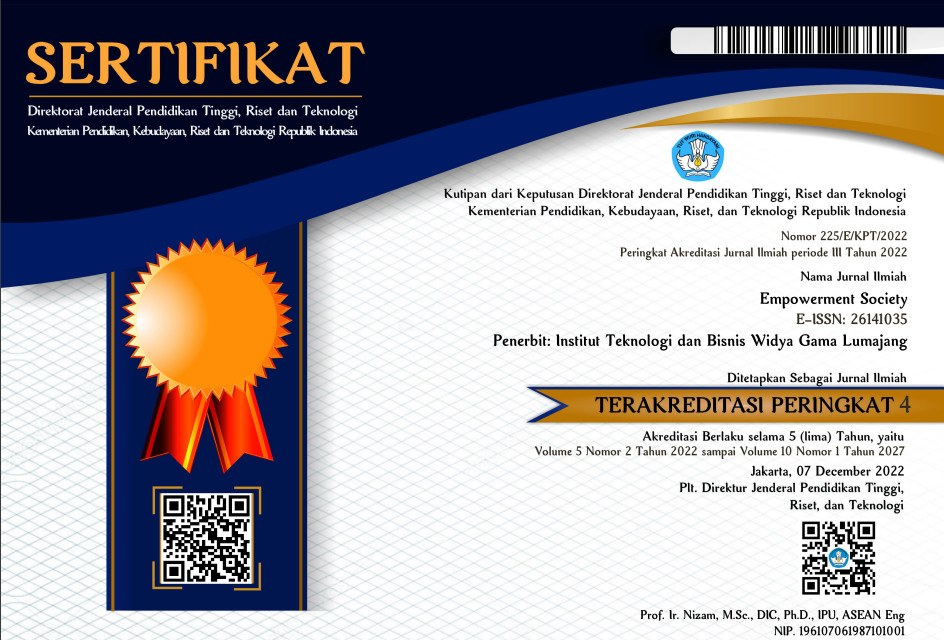Author Guideline
EMPOWERMENT SOCIETY is a proper channel for publication of papers in Society Development and Engagement. Manuscripts reporting experimentation or research in field crops will be accepted for review as papers.
GUIDING PRINCIPLES
An acceptable manuscript will meet the following general criteria: it reports a worthwhile contribution to science, sound methodology was used and is explained with sufficient detail so that other capable scientists could repeat the experiments. Conclusions are supported by data, manuscripts are concise, well written, and understandable.
MANUSCRIPT FORMAT
The manuscript should be uploaded to the ENGAGEMENT system and arranged in a standard format, Title, Authors, Address, and Email, Abstract, Keywords, Introduction, Materials and Methods, Result and Discussion, Conclusion, Acknowledgment, and References. Typed at one side of white paper of A4 size, in a single column, 1.5 space line, 12 point Garamond font and should be given line numbers. Margins on all four sides are 2 cm.
MANUSCRIPT TITLE
The title of the paper should be concise and informative. Avoid abbreviations and formulas where possible. It should be written clearly and concisely describing the contents of the research.
AUTHORS
The manuscript has the main author and co-authors with full name of the author and co-authors (no abbreviation), includes address (es) and email addresses clearly.
ABSTRACT
The abstract comes after the title page in the manuscript. The abstract must be integrated and independent which is consists of introduction and purpose, methods, results, conclusion, and suggestion. However, the abstract should be written as a single paragraph without these headers. For this reason, References should be avoided. Also, non-standard or uncommon abbreviations should be avoided, but if essential they must be defined at their first mention in the abstract itself. The abstract must be written using 150 until 200 words which have no reference and accompanied keywords.
KEYWORDS
The keywords should be avoiding general and plural terms and multiple concepts. Do not use words or terms in the title as keywords. These keywords will be used for indexing purposes. Keywords should not more than 5 words or phrases in alphabetical order.
INTRODUCTION
State the objectives of the work and provide an adequate background, avoiding a detailed literature survey or a summary of the results. Explain how you addressed the problem and clearly state the aims of your study. As you compose the introduction, think of readers who are not experts in this field. The introduction must be written using 750 until 1000 words
MATERIALS AND METHODS
It should mention the time and place of research in the first part. All materials and methods that used such chemicals for analysis, treatment, and experimental design must be stated clearly and briefly. State the objectives of the work and provide an adequate background, avoiding a detailed literature survey or a summary of the results. A Theory section should extend, not repeat, the background to the article already dealt with in the Introduction and lays the foundation for further work. a Calculation section represents a practical development from a theoretical basis. Materials and methods must be written using 400 until 600 words.
RESULTS AND DISCUSSION
The result and discussion must be written in the same part. They should be presented continuously start from the main result to the supporting results and equipped with a discussion. The unit of measurement used should follow the prevailing international system. All figures and tables placed separately at the end of manuscript pages and should be active and editable by the editor.
CONCLUSION
The conclusion should be explained clearly. Suggestion placed after the conclusion contains a recommendation on the research done or an input that can be used directly by the consumer. Conclusion and suggestion must be written using 40 until 80 words.
ACKNOWLEDGMENT
State the grant source and the person to whom the grant was given. Name the person to help you work.
REFERENCES
The author-year notation system is required and completed. All references mentioned should be written down in reference using the American Turabian 8th Edition style and arranged from A to Z. Articles have 10 recent references or over and 80% is the journal. The most of references are the primary ones (last ten years). Unpublished data and personal communication should not be cited as literature citations. “In Press” articles that have been accepted for publication may be cited in references. Include in the citation the journal in which the “in press” article will appear and the publication date if a date is available.
Example
Reference to a Journal Publication:
Abdallah, E. H., Musa, Y., Mustafa, M., Sjahril, R., & Riadi, M. (2013). Comparison between hydro- and osmo-priming to determine the period needed for priming indicator and its effect on germination percentage of aerobic rice cultivars (Oryza sativa L.). AGRIVITA Journal of Agricultural Science, 38(3), 222-230. http://doi.org/10.17503/agrivita.v38i3.886
Reference to a Book:
Bolda, M. L., Tourte, L., Klonsky, K. M., & de Moura, R. L. (2005). Sample cost to produce fresh market raspberries. Berkeley, US: University of California Cooperative extension.
Reference to a Chapter in an Edited Book:
Tuong, T. P., & Bouman, B. A. M. (2003). Rice production in water-scarce environments. In W. Kijne, R. Barker, & D. Molden (Eds.), Water productivity in agriculture: Limits and opportunities for improvement (pp. 53–67). Manila, PH: CAB International.
Reference in Proceeding:
Hapsari, L. & Masrum, A. (2011). Diversity and characteristics of banana (Musa acuminata) diploid AA cultivars group collection of Purwodadi botanic garden. In D. Widyatmoko, D. M. Puspitaningtyas, R. Hendrian, Irawati, I. A. Fijridiyanto, J. R. Witono, R. Rosniati, S. R. Ariati, S. Rahayu, & T. Ng Praptosuwiryo (Eds.), Conservation of tropical plants: Current condition and future challenge. Paper presented at Proceedings of Seminar Cibodas Botanic Garden 159th Anniversary, Cibodas (pp. 225-229). Cibodas, ID: Indonesian Institute of Sciences









